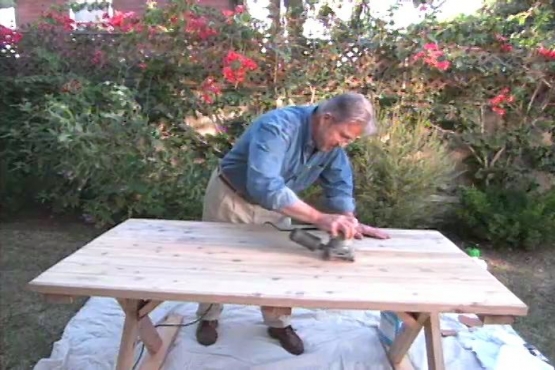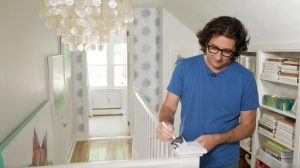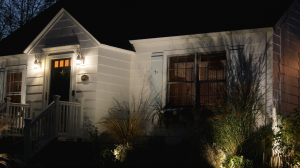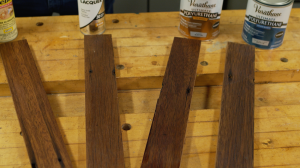RON HAZELTON:
Kenneth and Andretta Allen of New Orleans, Louisiana have asked for a little help. So I'm going to pay them a house call.
Ai yai yai yai yai. I don't know. It’s beyond, this may be beyond help here. At first glance, it doesn't look good. The deck boards are splintered and have faded to a dingy shade of gray. Kenneth shows me a few other problems. Some of boards have actually twisted out of place and nail heads are popping up all over.
DENNIS:
I can't tell you how many times I've pounded these things down. They have a way of coming - creeping back up though.
RON HAZELTON:
Things looked pretty bad all right. But nonetheless, I'm fairly confident a revival is possible. Several of the problems that you see on this deck - the popping nails, the cracks on the surfaces of the board, the twisting lumber are caused by the wood getting wet, soaking up water, expanding and then drying out and contracting. That continual movement, expansion and contraction causes almost all of these problems. And the way to prevent it is to make sure that you put a good sealer on your deck every year or two.
But our first step is to fix those twisted planks. And we begin by removing the old nails. I drive the prongs of a nail puller beneath the heads and then Andretta pries them out with the other end. Next we'll try to straighten out those boards. Now this is my high tech deck board straightening tool right here.
What I've done is taken a two by four, cut a notch out of it. And this is how it's going to work, I hope. This slips right over the end of the twisted two by four like this.
DENNIS:
Wow, that's a great idea. Andretta would have never thought of that.
RON HAZELTON:
Oh I don't know, I bet she might have.
ANDRETTA:
No, I wouldn't have.
RON HAZELTON:
Want to give it a push, see if it works.
ANDRETTA:
Yes.
RON HAZELTON:
That should straighten that board right up.
DENNIS:
Oh that's great.
RON HAZELTON:
Kenneth reattaches the problem plank with 5 inch screws. Which create a stronger grip for nails. The real advantage to fixing this board rather than replacing it is that we won't wind up with a strip of new lumber that doesn't match the rest of the deck.
There we go.
[BOTH SPEAK AT ONCE]
RON HAZELTON:
What about that?
DENNIS:
Great idea.
ANDRETTA:
Perfect. Such a simple solution to what was a big problem.
DENNIS:
Well we would have went to the store and bought all kinds of contraptions and it probably wouldn't have worked as easy as this.
RON HAZELTON:
With the twisted board straightened out, we turn our attention to those popping nails. The ones we can grip with a nail puller, we remove, replacing them with nails that are thicker and slightly longer for better holding power.
For the nails that are nearly flush with the surface, we use a drift punch to counter sink them slightly. A few of these old boards though just won't lie flat. And require a bit of encouragement from Kenneth. This is called trust.
Do you trust me?
DENNIS:
Oh potential lawsuit.
RON HAZELTON:
With all the nails driven in, we're ready to clean the deck with a deck wash and brightener made just for the purpose. We pour the solution into a garden sprayer and I wet the deck thoroughly. Kenneth and Andretta follow behind, lightly scrubbing.
But it's the chemicals that are really doing most of the work. Loosening the accumulated dirt and bleaching out stains and discolorations. After about 15 minutes, we begin rinsing off the cleaning and bleaching solution using a pressure washer that connects to a garden hose and boosts household water pressure by about 15 times. The high pressure water produces a scrubbing effect as it rinses off the chemicals. To see just how well the deck is responding, we stop midway and make a comparison.
Now see, here's your old board right here.
ANDRETTA:
Yes.
RON HAZELTON:
That's the new board with the deck wash and the power sprayer.
ANDRETTA:
Yes.
RON HAZELTON:
And you can see none of this is hard work.
ANDRETTA:
No, it isn't.
RON HAZELTON:
Well enough admiring our progress. We refill the garden sprayer and go back to work. After the cleaning is complete and the surface dry, it's becoming clear the deck that was once presumed ready for the kindling pile is well on its way to a comeback. Clean?
ANDRETTA:
It's beautiful.
RON HAZELTON:
It's bright.
ANDRETTA:
Yes.
RON HAZELTON:
It's ready for a little sealer.
DENNIS:
It looks really, really great.
RON HAZELTON:
Would you have believed this was underneath all that?
ANDRETTA:
No.
RON HAZELTON:
Our next step is to refill the garden sprayer. This time with a deck sealer that will help restore the wood's color and protect it from weathering.
All right guys. Now what we want to try to do here is keep this maybe about a foot or so away from the deck.
And move it back and forth in a nice even motion like that. Keeping the sprayer head a consistent distance from the surface will insure a uniform coating. This sealer goes on milky, but it dries clear. The main purpose of the sealer is to slow down the rate at which the wood absorbs water.
And greatly reduce the expansion and contraction that caused most of this cracking and nail popping. Couldn’t be easier, huh?
DENNIS:
This goes on great.
RON HAZELTON:
Now this product - given your conditions here will probably seal your deck for one to two years. It's just amazing how quickly you can apply sealer with a garden sprayer. Before we know it, we're finished.
DENNIS:
Didn't even take us 20 minutes to do this whole deck.
ANDRETTA:
No. We have no excuse now. Not to maintain it.
RON HAZELTON:
Did you say that?
ANDRETTA:
Yes, I did.
RON HAZELTON:
It's always so much better when it comes from you.
[LAUGHTER]
RON HAZELTON:
Than me. The deck sealer needs to dry for several hours before getting any foot traffic. And overnight before we can replace the furniture. But that doesn't keep us from admiring our success from a distance. I gotta tell you, I feel like we've gone back in time.
I mean this deck probably looks like it did pretty much the day it was put down.
DENNIS:
I've never seen it look like this.
RON HAZELTON:
It was here when you bought the house, right?
ANDRETTA:
It was here when we bought the house.
DENNIS:
Never looked this good.
RON HAZELTON:
And it was pretty easy too.
ANDRETTA:
Yes.
DENNIS:
Yeah it was a little work, but it was a lot easier than I would have ever thought it would have been.
RON HAZELTON:
Good. Glad to hear that.
DENNIS:
It looks great.
RON HAZELTON:
Because this isn't the real reason Andretta had me come here. This was your trial project. And now that you found it so easy, the real job is this fence. Runs all the way around the property here.
ANDRETTA:
All the way around. Cool.
RON HAZELTON:
Cool huh? Can you do it with dad now?
CHILD:
Yeah.
RON HAZELTON:
Now honestly, when you first saw this deck, did you think it could turn out this well? You know, there’s a lot of satisfaction in restoring
Things. Oftentimes, you find renewed beauty just beneath the surface. How appropriate that we discover that here in New Orleans. Where people know the value of restoring the past.







